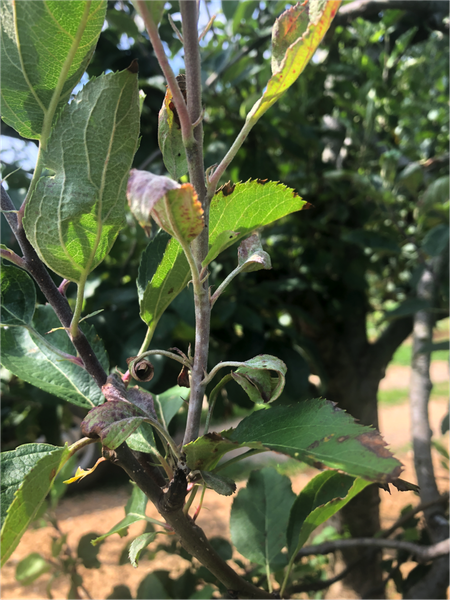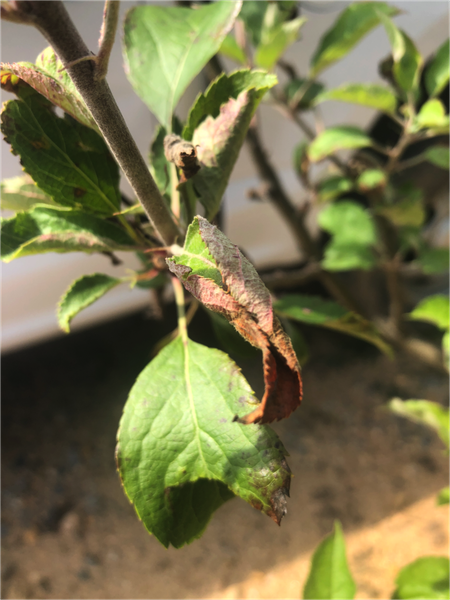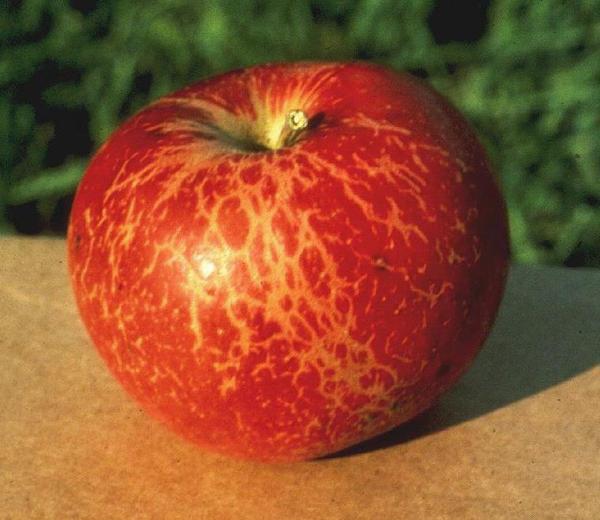Introduction
Powdery mildew is a disease of apple that affects apples leaves, young shoots, flowers, and fruit. Apple powdery mildew is present in all apple growing regions of the United States, but tends to be most severe in the Pacific Northwest, where netlike russeting on fruit can severely impact the value of the crop.
Pathogen
Apple powdery mildew is caused by the fungal pathogen Podosphaera leucotricha.
Symptoms and Signs
Primary powdery mildew: Primary mildew infection occurs as green tissue emerges from infected terminal buds in the spring. Primary infections appear as silver to white colored stunted or malformed shoots covered in white spores of the powdery mildew fungus. As the season progresses, shoot dieback, severe leaf curling, or dried / cracked lesions may be apparent on shoots infected with primary mildew.
Secondary powdery mildew infection: Secondary powdery mildew appears as distinct white lesions on the front (or occasionally backside) of young, developing leaves. The white, felt-like appearance of the lesion is due to conidia (spores) of the powdery mildew on the surface of the leaf. As the season progresses, the mildew may appear "burnt out" or red in color, particularly along back edges of leaves.
Fruit infection: When powdery mildew infection is severe, fruit may become infected. Net- or webbed-like russeting on the fruit surface is the most obvious symptom of fruit infection.
Disease Cycle
The powdery mildew pathogen, Podosphaera leucotricha, overwinters as mycelium in buds of terminal shoots that were infected during the previous season. As early as tight cluster, conidia are produced from the overwintering mycelium and infect emerging shoot and leaf tissue (primary infection). Conidia from shoots with primary powdery mildew infection are dispersed by wind and can infect flowers / fruit and young leaves (secondary infection). Although older leaves are resistant to infection (ontogenic resistance), a resurgence in terminal growth during the mid to late summer can result in renewed mildew activity.
Unlike many other fungal pathogens, spores of P. leucotricha do not germinate in free water. Rather, germination and subsequent infection is favored during conditions of high relative humidity and temperatures between 66-72°F.
Management
Effective management of apple powdery mildew should involve consideration of host susceptibility, tolerance for fruit infection (usually fresh market vs. processing), and fungicide efficacy.
Host Resistance
There is a wide range in susceptibility of apple cultivars to powdery mildew. Cultivars with greater susceptibility to the disease include Cortland, Rome Beauty, Granny Smith, Honeycrisp, Ginger Gold, Jonagold, and GoldRush. Red Delicious, Golden Delicious, Stayman, Fuji, and Gala tend to be more resistant (i.e. less susceptible) to powdery mildew.
Fungicides
Secondary powdery mildew infections can be managed by foliar fungicide applications. In North Carolina, applications targeting powdery mildew should begin at tight cluster and continue until susceptible leaf tissue is not longer available (end of terminal shoot growth). Depending on the weather conditions, cultivar susceptibility, and physical mode of action of the applied fungicide, applications targeting powdery mildew should be maintained on a 7 to 14 day interval in the Southeastern United States, using a tighter interval during periods of rapid shoot elongation / growth. In general, highly susceptible leaves that emerged after a fungicide application will not be protected. Several S.I. fungicides (FRAC 3) and strobilurin fungicides (FRAC 11) have demonstrated excellent control against powdery mildew. Conversely, mancozeb and captan do not provide adequate control against the disease.
| Active Ingredient | Example Formulated Product | Pre-harvest Interval (days) | FRAC Code |
|---|---|---|---|
| myclobutanil | Rally 40WSP | 14 | 3 |
| triflumizole | Procure 480SC | 14 | 3 |
| flutriafol | Topguard Fungicide Specialty Crops | 14 | 3 |
| trifloxystrobin | Flint Extra | 14 | 11 |
| kresoxim-methyl | Sovran | 30 | 11 |
| pyraclostrobin + fluxapyroxad | Merivon | 0 | 11 + 7 |
| trifloxystrobin + fluopyram | Luna Sensation | 14 | 11 + 7 |
| sulfur | Microthiol Disperss | 1 | M2 |
Publication date: July 3, 2018
N.C. Cooperative Extension prohibits discrimination and harassment regardless of age, color, disability, family and marital status, gender identity, national origin, political beliefs, race, religion, sex (including pregnancy), sexual orientation and veteran status.
Recommendations for the use of agricultural chemicals are included in this publication as a convenience to the reader. The use of brand names and any mention or listing of commercial products or services in this publication does not imply endorsement by NC State University or N.C. A&T State University nor discrimination against similar products or services not mentioned. Individuals who use agricultural chemicals are responsible for ensuring that the intended use complies with current regulations and conforms to the product label. Be sure to obtain current information about usage regulations and examine a current product label before applying any chemical. For assistance, contact your local N.C. Cooperative Extension county center.
N.C. Cooperative Extension prohibits discrimination and harassment regardless of age, color, disability, family and marital status, gender identity, national origin, political beliefs, race, religion, sex (including pregnancy), sexual orientation and veteran status.





